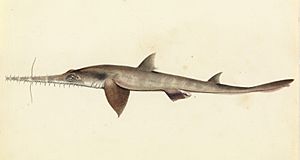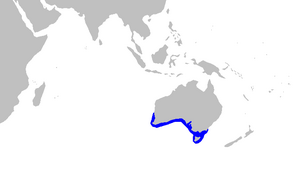Longnose sawshark facts for kids
Quick facts for kids Longnose sawshark |
|
|---|---|
 |
|
| Pristiophorus cirratus, from the Sketchbook of fishes by William Buelow Gould, 1832 | |
| Conservation status | |
| Scientific classification | |
| Genus: |
Pristiophorus
|
| Species: |
cirratus
|
 |
|
| Range of longnose sawshark (in blue) | |
The longnose sawshark (Pristiophorus cirratus) is also known as the common sawshark. It is a type of sawshark that belongs to the family called Pristiophoridae. These sharks are known for their very long, flat snouts that look like a saw.
Contents
What Does It Look Like?
The longnose sawshark has a thin body that is a bit flat. Its most special feature is its very long nose, called a rostrum. This "saw" can be almost one-third of its total body length!
These sharks are usually pale yellow or grayish-brown on top. Their bellies are white. They often have faint dark spots, blotches, or stripes on their backs.
The longnose sawshark also has two special feelers, called barbels. These are about halfway down its long nose. An adult longnose sawshark can grow up to 1.37 m (4 ft 6 in) long.
You might confuse a longnose sawshark with a sawfish. Sawfish are actually a type of ray, not a shark. A key difference is where their gills are. Sawsharks have five gills on the sides of their head. Sawfish have their gills on the underside of their head.
Where Do They Live?
Longnose sawsharks live in the eastern Indian Ocean. You can find them around southern Australia and Tasmania. They usually stay on the continental shelf, which is the edge of the land that slopes into the ocean.
They live in waters that are quite deep, from 20 to 600 meters (about 65 to 1,970 feet) down. While they might sometimes swim into bays, they prefer sandy or gravelly areas offshore.
Life and Habits
What They Eat
Longnose sawsharks mostly eat small crustaceans. These are creatures like crabs and shrimp. They use their barbels (feelers) to search for food along the ocean floor. Once they find something, they use the teeth on their long, saw-like snout to stir up the sand and catch their prey.
Reproduction and Life Cycle
Like all sawsharks, the longnose sawshark gives birth to live young. This is called ovoviviparous reproduction. This means the eggs hatch inside the mother's body, and then the pups are born live.
Longnose sawsharks have babies every other winter. A mother can have between 6 and 19 pups in one litter. The babies grow inside the mother for about 12 months. When they are born, they are about 27–37 cm (11–15 in) long. Their "saw" teeth are folded back against their snout at birth. This protects the mother from getting hurt during birth.
Compared to many other shark species, longnose sawsharks grow up quickly. They also don't live as long, usually around 15 years.
Sawsharks and People
The International Union for the Conservation of Nature (IUCN) lists the longnose sawshark as "Least Concern." This means they are not currently in danger of disappearing. They used to be listed as "Near Threatened," but new information showed their numbers are stable.
Laws help protect longnose sawsharks and keep their fishing rates steady. Also, large areas where they live are protected from all shark fishing. This helps their populations stay healthy.
Their meat is quite popular in Australia. People say it tastes excellent. Because longnose sawsharks live in deep waters and generally avoid humans, they are not considered a threat to people.
See also
 In Spanish: Tiburón sierra trompudo para niños
In Spanish: Tiburón sierra trompudo para niños


